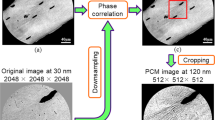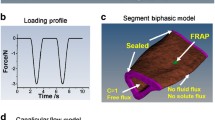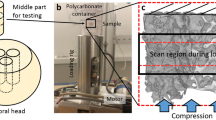Abstract
Osteocytes are hypothesized to regulate bone remodeling guided by both biological and mechanical stimuli. Morphology of the lacunar–canalicular network of osteocytes has been hypothesized to be strongly related to the level of mechanical loading and to various bone diseases. Finite element modeling could help to better understand the mechanosensation process by predicting the physiological strain environment. The aims of this study were to (i) quantify the lacunar–canalicular morphology in the cortex of the human femur; (ii) predict the in situ local deformations around and in osteocytes by means of case-specific finite element models; and (iii) investigate the potential relationship between morphology and deformations. Human femoral cortical bone samples were imaged using synchrotron X-ray phase nano-tomography with 50 nm voxel size. Rectangular volumes of interest were selected to contain single osteocyte lacunae and the surrounding matrix. Lacunar–canalicular morphology was quantified and the cell geometry was artificially reconstructed based on a priori assumptions. Finite element models of the volumes of interest were generated, containing the extracellular matrix, osteocyte and peri-cellular matrix, and subjected to uniaxial compression. The morphological analysis revealed that canalicular number was dictated by lacunar size, that the spacing of canaliculi fell within a narrow range, suggesting that these pores are well distributed throughout the bone matrix and indicated the trend that lacunae at the outer osteon boundary were less elongated than others. No apparent relationship was found between the morphological parameters and the predicted strains. The globally applied strain was amplified locally by factors up to 10 and up to 70 in the extracellular matrix and the in cells, respectively. Cell deformations were localized mainly at the body–dendrite junctions, with magnitudes reaching the in vitro stimulatory threshold reported for osteocytes.








Similar content being viewed by others
References
Adachi T, Aonuma Y, Tanaka M, Hojo M, Takano-Yamamoto T, Kamioka H (2009) Calcium response in single osteocytes to locally applied mechanical stimulus: differences in cell process and cell body. J Biomech 42(12):1989–1995
Anderson EJ, Knothe Tate ML (2008) Idealization of pericellular fluid space geometry and dimension results in a profound underprediction of nano-microscale stresses imparted by fluid drag on osteocytes. J Biomech 41(8):1736–1746
Bayraktar HH, Morgan EF, Niebur GL, Morris GE, Wong EK, Keaveny TM (2004) Comparison of the elastic and yield properties of human femoral trabecular and cortical bone tissue. J Biomech 37(1):27–35
Bonewald LF (2011) The amazing osteocyte. J Bone Miner Res 26(2):229–238
Bonivtch AR, Bonewald LF, Nicolella DP (2007) Tissue strain amplification at the osteocyte lacuna: a microstructural finite element analysis. J Biomech 40(10):2199–2206
Burr DB, Milgrom C, Fyhrie D, Forwood M, Nyska M, Finestone A, Hoshaw S, Saiag E, Simkin A (1996) In vivo measurement of human tibial strains during vigorous activity. Bone 18(5):405–410
Burra S, Nicolella DP, Francis WL, Freitas CJ, Mueschke NJ, Poole K, Jiang JX (2010) Dendritic processes of osteocytes are mechanotransducers that induce the opening of hemichannels. Proc Natl Acad Sci USA 107(31):13,648–13,653
Carter Y, Thomas CDL, Clement JG, Peele AG, Hannah K, Cooper DML (2013) Variation in osteocyte lacunar morphology and density in the human femur-a synchrotron radiation micro-ct study. Bone 52(1):126–132
Currey JD (2003) The many adaptations of bone. J Biomech 36(10):1487–1495
Dall’Ara E, Luisier B, Schmidt R, Pretterklieber M, Kainberger F, Zysset P, Pahr D (2013) Dxa predictions of human femoral mechanical properties depend on the load configuration. Med Eng Phys 35(11):1564–1572; discussion 1564
Deligianni DD, Apostolopoulos CA (2008) Multilevel finite element modeling for the prediction of local cellular deformation in bone. Biomech Model Mechanobiol 7(2):151–159
Dempster DW, Compston JE, Drezner MK, Glorieux FH, Kanis JA, Malluche H, Meunier PJ, Ott SM, Recker RR, Parfitt AM (2013) Standardized nomenclature, symbols, and units for bone histomorphometry: a 2012 update of the report of the asbmr histomorphometry nomenclature committee. J Bone Miner Res 28(1):2–17
Dierolf M, Menzel A, Thibault P, Schneider P, Kewish CM, Wepf R, Bunk O, Pfeiffer F (2010) Ptychographic x-ray computed tomography at the nanoscale. Nature 467(7314):436–439
Dong P, Haupert S, Hesse B, Langer M, Gouttenoire PJ, Bousson V, Peyrin F (2014) 3d osteocyte lacunar morphometric properties and distributions in human femoral cortical bone using synchrotron radiation micro-ct images. Bone 60:172–185
Dooley C, Tisbo P, Lee TC, Taylor D (2012) Rupture of osteocyte processes across microcracks: the effect of crack length and stress. Biomech Model Mechanobiol 11(6):759–766
Doube M, Kosowski MM, Arganda-Carreras I, Cordelires FP, Dougherty RP, Jackson JS, Schmid B, Hutchinson JR, Shefelbine SJ (2010) Bonej: Free and extensible bone image analysis in imagej. Bone 47(6):1076–1079
Fratzl P, Weinkamer R (2007) Natures hierarchical materials. Progress Mater Sci 52(8):1263–1334
Gupta HS, Seto J, Wagermaier W, Zaslansky P, Boesecke P, Fratzl P (2006) Cooperative deformation of mineral and collagen in bone at the nanoscale. Proc Natl Acad Sci USA 103(47):17,741–17,746
Han Y, Cowin SC, Schaffler MB, Weinbaum S (2004) Mechanotransduction and strain amplification in osteocyte cell processes. Proc Natl Acad Sci USA 101(47):16,689–16,694
Hesse B, Langer M, Varga P, Pacureanu A, Dong P, Schrof S, Männicke N, Suhonen H, Olivier C, Maurer P, Kazakia GJ, Raum K, Peyrin F (2014) Alterations of mass density and 3d osteocyte lacunar properties in bisphosphonate-related osteonecrotic human jaw bone, a synchrotron ct study. PLoS One 9(2):e88,481
Hildebrand T, Rüegsegger P (1997) A new method for the model-independent assessment of thickness in three-dimensional images. J Microsc 185(1):67–75
Kamioka H, Murshid SA, Ishihara Y, Kajimura N, Hasegawa T, Ando R, Sugawara Y, Yamashiro T, Takaoka A, Takano-Yamamoto T (2009) A method for observing silver-stained osteocytes in situ in 3-\(\mu \text{ m }\) sections using ultra-high voltage electron microscopy tomography. Microsc Microanal 15:377–383
Kamioka H, Kameo Y, Imai Y, Bakker AD, Bacabac RG, Yamada N, Takaoka A, Yamashiro T, Adachi T, Klein-Nulend J (2012) Microscale fluid flow analysis in a human osteocyte canaliculus using a realistic high-resolution image-based three-dimensional model. Integr Biol 4(10):1198–1206
Kerschnitzki M, Wagermaier W, Roschger P, Seto J, Shahar R, Duda GN, Mundlos S, Fratzl P (2011) The organization of the osteocyte network mirrors the extracellular matrix orientation in bone. J Struct Biol 173(2):303–311
Kerschnitzki M, Kollmannsberger P, Burghammer M, Duda GN, Weinkamer R, Wagermaier W, Fratzl P (2013) Architecture of the osteocyte network correlates with bone material quality. J Bone Miner Res 28(8):1837–1845
Klein-Nulend J, van der Plas A, Semeins CM, Ajubi NE, Frangos JA, Nijweide PJ, Burger EH (1995) Sensitivity of osteocytes to biomechanical stress in vitro. FASEB J 9(5):441–445
Klein-Nulend J, Bakker AD, Bacabac RG, Vatsa A, Weinbaum S (2013) Mechanosensation and transduction in osteocytes. Bone 54(2):182–190
Knothe Tate ML, Tami AEG, Bauer TW, U K (2002) Micro- pathoanatomy of osteoporosis: indications for a cellular basis of bone disease. Adv Osteoporotic Fract Manag 2:9–14
Langer M, Pacureanu A, Suhonen H, Grimal Q, Cloetens P, Peyrin F (2012) X-ray phase nanotomography resolves the 3d human bone ultrastructure. PLoS One 7(e35):691
Liebschner MAK (2004) Biomechanical considerations of animal models used in tissue engineering of bone. Biomaterials 25(9):1697–1714
Loiselle AE, Jiang JX, Donahue HJ (2013) Gap junction and hemichannel functions in osteocytes. Bone 54(2):205–212
Manolagas SC, Parfitt AM (2013) For whom the bell tolls: distress signals from long-lived osteocytes and the pathogenesis of metabolic bone diseases. Bone 54(2):272–278
Marotti G (1990) The original contributions of the scanning electron microscope to the knowledge of bone structure. In: Bonucci E, Motta P (eds) Ultrastructure of skeletal tissues, electron microscopy in biology and medicine, vol 7. Springer, US, pp 19–39. doi:10.1007/978-1-4613-1487-5-2
Marotti G, Cane V, Palazzini S, Palumbo C (1990) Structure-function relationships in the osteocyte. Ital J Miner Electrolyte Metab 4:93–106
McCreadie BR, Hollister SJ, Schaffler MB, Goldstein SA (2004) Osteocyte lacuna size and shape in women with and without osteoporotic fracture. J Biomech 37(4):563–572
McGarry JG, Klein-Nulend J, Mullender MG, Prendergast PJ (2005) A comparison of strain and fluid shear stress in stimulating bone cell responses-a computational and experimental study. FASEB J 19(3):482–484
McNamara LM, Majeska RJ, Weinbaum S, Friedrich V, Schaffler MB (2009) Attachment of osteocyte cell processes to the bone matrix. Anat Rec (Hoboken) 292(3):355–363
Milovanovic P, Zimmermann EA, Hahn M, Djonic D, Pschel K, Djuric M, Amling M, Busse B (2013) Osteocytic canalicular networks: morphological implications for altered mechanosensitivity. ACS Nano 7(9):7542–7551
Mullender MG, Tan SD, Vico L, Alexandre C, Klein-Nulend J (2005) Differences in osteocyte density and bone histomorphometry between men and women and between healthy and osteoporotic subjects. Calcif Tissue Int 77(5):291–296
Nguyen AM, Jacobs CR (2013) Emerging role of primary cilia as mechanosensors in osteocytes. Bone 54(2):196–204
Nicolella DP, Moravits DE, Gale AM, Bonewald LF, Lankford J (2006) Osteocyte lacunae tissue strain in cortical bone. J Biomech 39(9):1735–1743
Pacureanu A, Langer M, Boller E, Tafforeau P, Peyrin F (2012) Nanoscale imaging of the bone cell network with synchrotron X-ray tomography: optimization of acquisition setup. Med Phys 39(4):2229–2238
Price C, Zhou X, Li W, Wang L (2011) Real-time measurement of solute transport within the lacunar–canalicular system of mechanically loaded bone: direct evidence for load-induced fluid flow. J Bone Miner Res 26(2):277–285
Qing H, Ardeshirpour L, Pajevic PD, Dusevich V, Jhn K, Kato S, Wysolmerski J, Bonewald LF (2012) Demonstration of osteocytic perilacunar/canalicular remodeling in mice during lactation. J Bone Miner Res 27(5):1018–1029
Qiu S, Rao DS, Palnitkar S, Parfitt AM (2003) Reduced iliac cancellous osteocyte density in patients with osteoporotic vertebral fracture. J Bone Miner Res 18(9):1657–1663
Qiu S, Rao DS, Fyhrie DP, Palnitkar S, Parfitt AM (2005) The morphological association between microcracks and osteocyte lacunae in human cortical bone. Bone 37(1):10–15
Rath AL, Bonewald LF, Ling J, Jiang JX, Van Dyke ME, Nicolella DP (2010) Correlation of cell strain in single osteocytes with intracellular calcium, but not intracellular nitric oxide, in response to fluid flow. J Biomech 43(8):1560–1564
Ruffoni D, Fratzl P, Roschger P, Klaushofer K, Weinkamer R (2007) The bone mineralization density distribution as a fingerprint of the mineralization process. Bone 40(5):1308–1319
Schindelin J, Arganda-Carreras I, Frise E, Kaynig V, Longair M, Pietzsch T, Preibisch S, Rueden C, Saalfeld S, Schmid B, Tinevez JY, White DJ, Hartenstein V, Eliceiri K, Tomancak P, Cardona A (2012) Fiji: an open-source platform for biological-image analysis. Nat Methods 9(7):676–682
Schneider P, Meier M, Wepf R, Müller R (2010) Towards quantitative 3d imaging of the osteocyte lacuno-canalicular network. Bone 47(5):848–858
Schneider P, Meier M, Wepf R, Müller R (2011) Serial fib/sem imaging for quantitative 3d assessment of the osteocyte lacuno-canalicular network. Bone 49(2):304–311
Schneider P, Ruffoni D, Larsson D, Chiapparini I, Müller R (2012) Imagebased finite element models for the investigation of osteocyte mechanotransduction. J Biomech 45:S436
Sharma D, Ciani C, Marin PAR, Levy JD, Doty SB, Fritton SP (2012) Alterations in the osteocyte lacunar–canalicular microenvironment due to estrogen deficiency. Bone 51(3):488–497
Stalling D, Westerhoff M, Hege HC (2005) Amira: a highly interactive system for visual data analysis. In: Hansen CD, Johnson CR (eds) The Visualization Handbook. Elsevier, Amsterdam, pp 749–767
Sugawara Y, Kamioka H, Honjo T, Ki Tezuka, Takano-Yamamoto T (2005) Three-dimensional reconstruction of chick calvarial osteocytes and their cell processes using confocal microscopy. Bone 36(5):877–883
Tiburtius S, Schrof S, Molnr F, Varga P, Peyrin F, Grimal Q, Raum K, Gerisch A (2014) On the elastic properties of mineralized turkey leg tendon tissue: multiscale model and experiment. Biomech Model Mechanobiol 1–21
van Hove RP, Nolte PA, Vatsa A, Semeins CM, Salmon PL, Smit TH, Klein-Nulend J (2009) Osteocyte morphology in human tibiae of different bone pathologies with different bone mineral density-is there a role for mechanosensing? Bone 45(2):321–329
Varga P, Pacureanu A, Langer M, Suhonen H, Hesse B, Grimal Q, Cloetens P, Raum K, Peyrin F (2013) Investigation of the three-dimensional orientation of mineralized collagen fibrils in human lamellar bone using synchrotron x-ray phase nano-tomography. Acta Biomater 9(9):8118–8127
Vatsa A, Breuls RG, Semeins CM, Salmon PL, Smit TH, Klein-Nulend J (2008) Osteocyte morphology in fibula and calvaria—is there a role for mechanosensing? Bone 43(3):452–458
Verbruggen SW, Vaughan TJ, McNamara LM (2012) Strain amplification in bone mechanobiology: a computational investigation of the in vivo mechanics of osteocytes. J R Soc Interface 9(75):2735–2744
Verbruggen SW, Vaughan TJ, McNamara LM (2014) Fluid flow in the osteocyte mechanical environment: a fluid-structure interaction approach. Biomech Model Mechanobiol 13(1):85–97
Wang Y, McNamara LM, Schaffler MB, Weinbaum S (2007) A model for the role of integrins in flow induced mechanotransduction in osteocytes. Proc Natl Acad Sci USA 104(40):15,941–15,946
Webster DJ, Schneider P, Dallas SL, Müller R (2013) Studying osteocytes within their environment. Bone 54(2):285–295
Weinbaum S, Cowin SC, Zeng Y (1994) A model for the excitation of osteocytes by mechanical loading-induced bone fluid shear stresses. J Biomech 27(3):339–360
WHO (2004) Who scientific group on the assessment of osteoporosis at primary health care level. Summary Meeting Report
Wolff J (1870) Über die innere architektur der knochen und ihre bedeutung für die frage vom knochenwachstum. Virchows Archiv 50(3):389–453
Wolff J (2010) The classic: on the inner architecture of bones and its importance for bone growth. 1870. Clin Orthop Relat Res 468(4):1056–1065
Wu D, Ganatos P, Spray DC, Weinbaum S (2011) On the electrophysiological response of bone cells using a stokesian fluid stimulus probe for delivery of quantifiable localized piconewton level forces. J Biomech 44(9):1702–1708
Yang PF, Brüggemann GP, Rittweger J (2011) What do we currently know from in vivo bone strain measurements in humans? J Musculoskelet Neuronal Interact 11(1):8–20
You J, Yellowley CE, Donahue HJ, Zhang Y, Chen Q, Jacobs CR (2000) Substrate deformation levels associated with routine physical activity are less stimulatory to bone cells relative to loading-induced oscillatory fluid flow. J Biomech Eng 122(4):387–393
You L, Cowin SC, Schaffler MB, Weinbaum S (2001) A model for strain amplification in the actin cytoskeleton of osteocytes due to fluid drag on pericellular matrix. J Biomech 34(11):1375–1386
You LD, Weinbaum S, Cowin SC, Schaffler MB (2004) Ultrastructure of the osteocyte process and its pericellular matrix. Anat Rec A Discov Mol Cell Evol Biol 278(2):505–513
Acknowledgments
The authors acknowledge the European Synchrotron Radiation Facility for allocating the beam time on ID22-NI within the experiment MD672. We thank Dr. Peter Cloetens for his excellent support during these measurements. We thank Dr. Enrico Dall’Ara for his help with sample preparation. PV gratefully acknowledges the European Union for providing funding through the grant PCIG09-GA-2011-293419. BH and NM are thankful for being supported by the BSRT. This work has been conducted within the European Associated Laboratory ‘Ultrasound Based Assessment of Bone’ and was partially supported by the Deutsche Forschungsgemeinschaft (SPP1420, grant Ra1380/7), by the LabEX PRIMES (‘Physics Radiobiology Medical Imaging and Simulation’) of the Universit de Lyon and by the French Agence Nationale de la Recherche.
Author information
Authors and Affiliations
Corresponding author
Electronic supplementary material
Below is the link to the electronic supplementary material.
Rights and permissions
About this article
Cite this article
Varga, P., Hesse, B., Langer, M. et al. Synchrotron X-ray phase nano-tomography-based analysis of the lacunar–canalicular network morphology and its relation to the strains experienced by osteocytes in situ as predicted by case-specific finite element analysis. Biomech Model Mechanobiol 14, 267–282 (2015). https://doi.org/10.1007/s10237-014-0601-9
Received:
Accepted:
Published:
Issue Date:
DOI: https://doi.org/10.1007/s10237-014-0601-9




